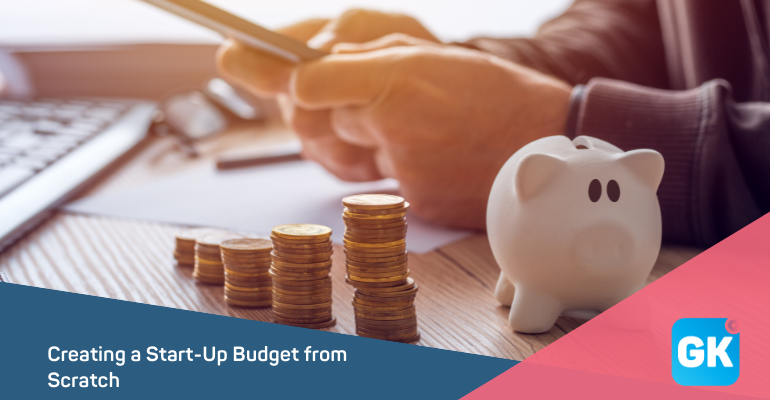How to Create a Start-up Budget from Scratch

Creating an effective budget is crucial to setting your business up for success. Without a clear understanding of your expected costs, the amount you need to succeed, and the amount of capital you have on-hand at any given time, you’ll likely never to be able to make the correct financial decision for your business. We have outlined the key elements of a start-up budget, to create an accurate budget for your start-up.
How is a Start-Up Budget Used?
The most straight forward use of a start-up budget is used to help businesses understand how much money they need to get their business off the ground and how much money they require to cover expected business expenses over a period of time.
Founders are expected to provide an estimate of how much capital they need to bring their business to life and achieve key milestones. Budgets are an important part of a business plan, required to secure business loans and they are an integral part of your fundraising deck.
How to Create an Effective Budget for Your Start-up
Creating a budget can be a daunting task for business owners. We have outlined the processes to help budgeting more approachable and ensure you don’t miss anything while creating a working budget for you start-up.
Step 1: Outline Potential Costs Related to Starting & Running Your Business
List all of the items required to start and grow your business during the first 12 months. Be specific about what you need and provide as much detail as possible. When listing all of your potential business expenses, make sure each line item includes estimated cost for a 12-month period. If you are unsure of costs associated with an item on your list, try to estimate a cost. Be generous in your estimates as its better to allocate extra funds for an item then discover you are short on cash in the future. It is suggested that start-ups pad their budgeted expenses by 10% to secure your business against cash shortages or unforeseen circumstances.
Step 2: Categorise Your Estimated Expenses
Now that you have a list of all expenses, you should organise these into three key categories.
- Essential Start-Up Costs: These are those which are required to get your business up and running. These tend to be one-time costs associated with getting your business off the ground. These might include business registration fees, computers, equipment, patents and more.
- Fixed Costs: These are the ongoing costs related to running a business. These costs exist regardless of your business performance. These might include rent/mortgage, salaries, insurance costs, website hosting, accounting and more.
- Variable Costs: These are expenses that can increase and decrease relative to your business output or business priorities at a given time. Variable expenses might include advertising, legal fees, sales software and more.
Step 3: Estimate Your Monthly Revenues
Various income sources may contribute to your monthly revenues. The most common sources of income for start-ups include:
- Sales: Start-up founders can generate sales projections using market research related to the products or services they are selling. Businesses with existing sales revenue can reference historical data from previous sales figures to estimate future sales.
- Investments and /or loans: Capital from any funding source should be itemised in this section.
Step 4: Calculate the Total Estimated Cost of Starting and Running Your Start-Up.
You have outlined many items which will help you determine the costs required to start and run your start-up, now you can add them up to find your budget starting point.
- Find Your Starting Point: Calculate the sum of all costs outlined in your spreadsheet during Step 1 to find your annual budget. Divide this figure by 12 to get your monthly business budget.
- Refine Costs, One Category at a Time: Begin sorting your budget document to view variable costs first. Some of these items may be ‘nice to haves’, not ‘need to haves’ in the early stage of business. Adjust items based on your business priority. Then look at your fixed costs, scrutinizing these and considering alternatives if any of these expenses appear to be pushing your budget beyond what is reasonable. Finally, look at your essential start-up costs and determine which are vital to get your business off the ground. Continue this exercise until you have arrived at a budget number that you comfortable with.
Step 5: Determine the Total Budget Number for Your Start-Up
Take the total start-up costs you calculated in step 4, broken down by month and compare them with your monthly revenue estimates. Determine if you are generating enough revenue to cover business costs. If not, you must refine your total costs or plan to secure additional capital to fuel your business.
Step 6: Put Budgeting Tools & Processes in Place for Ongoing Maintenance
Budgets should be revisited regularly, to analyse how your actual costs are tracking against your budget and make any necessary adjustments. Once your business has some financial infrastructure in place, it is suggested to use accounting software to automate lots of this data entry, keep your finances organised and have the ability to view performance regularly. It is important that start-up businesses create solid accounting and bookkeeping processes from the beginning of their business journey.
Gallagher Keane Automated Bookkeeping
Gallagher Keane maintain their entire practise using cloud accounting software. This allows our clients to access their finance information online to make informed business decisions. Use of cloud accounting streamlines many tasks, saving you time, which allows you to focus on your business priorities. If you are interested in finding out more about Gallagher Keane’s online accounting services, why not book a no-obligation call with us.


